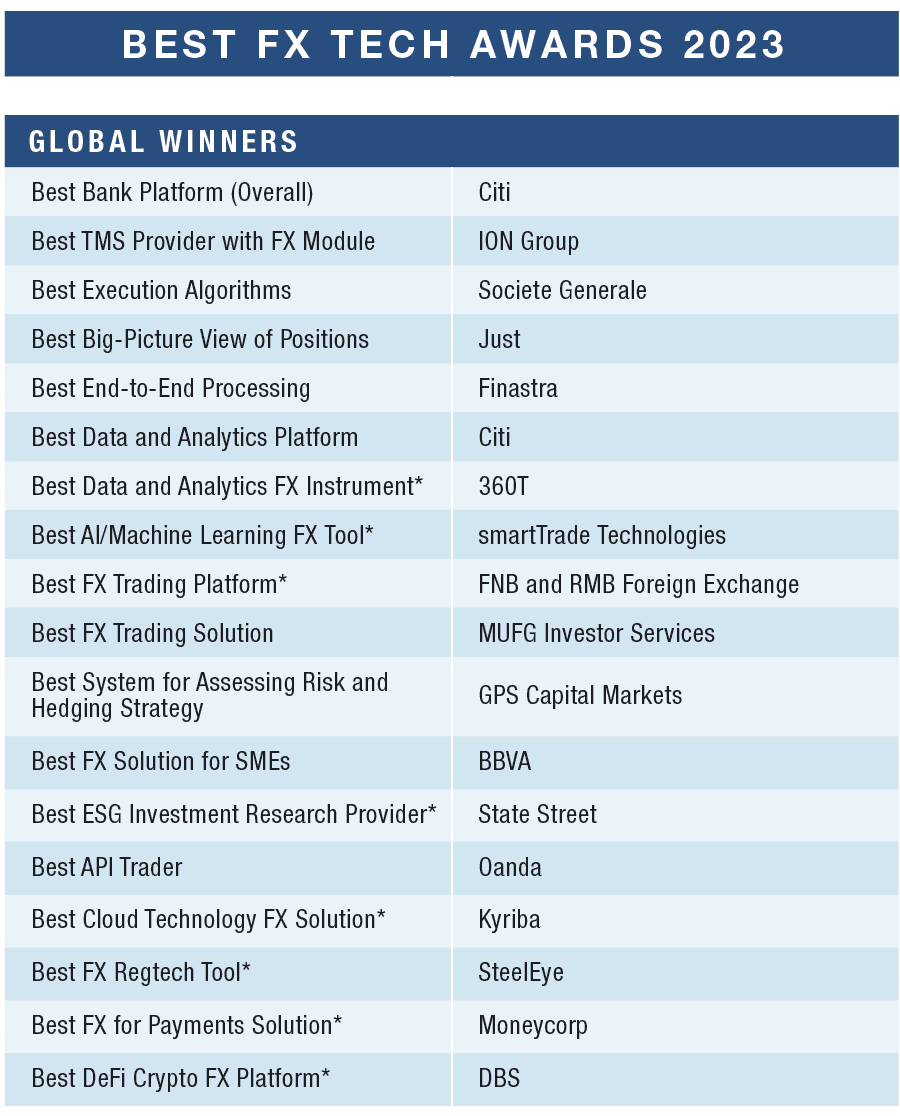Once seen as a plague on emerging markets, FX volatility hit major global currencies in a big way in 2022, due to rising interest rates, inflation and economic contraction.

Significant strengthening of the dollar following successive rounds of Fed interest rate hikes, Russia’s invasion of Ukraine and the subsequent rise in energy prices across Europe and beyond, Liz Truss’ disastrous premiership (which saw sterling come close to dollar parity) and China’s zero-Covid policy all helped create the biggest headwinds related to foreign exchange (FX) since global FX-impact data records began.
“In 2022, we entered a new era with the return of inflation after years of price stability. The impact on FX markets is indirect: Inflation numbers will drive central bank decisions, and central bank decisions will in turn drive FX markets,” explains Arnaud Lhoste, global head of Corporate Sales at Societe Generale, winner for Best Execution Algorithms. “This was obvious in 2022, as the Fed started raising rates well before the [European Central Bank], which resulted in extraordinary dollar strength.”
After last year’s extreme volatility, Lhoste expects somewhat greater stability in 2023. However, recent changes mean “we are now structurally in a higher volatility regime,” he notes, and getting less forward guidance. “Central bankers have not yet determined how much further they need to raise rates and when they will turn to stable or decreasing rates, but it is very clear in their communication that their decisions will be data dependent,” he says. “The most important data to watch now is the CPI [consumer price index]; all corporate treasurers should have all CPI publication dates circled in red in their agenda if they want to seize market opportunities for FX hedging.”
For corporations that once viewed FX management as a mere sideshow to their cross-border activities, managing currency risks is now an essential part of optimizing liquidity and protecting future cash revenues; and they are increasingly turning to technology to make better risk management and hedging decisions to manage FX risks more effectively and protect bottom lines.
GPS Capital Markets, 2023 winner for Best System for Assessing Risk and Hedging Strategy, developed FXpert, This client portal allows corporations to perform FX payments, balance sheet hedging, intercompany netting, balance reporting and cash flow forecasting; and it can be tailored to each individual client’s needs in a user-friendly way that helps the client to easily navigate and comprehend FX exposure.
“The process of hedging alone will not solve the complexities of hedging in a volatile market with changing interest rates and increasing hedging costs,” states Andy Gage, SVP of FX Solutions and Advisory Services at Kyriba, named for Best Cloud Technology FX Solution. “Companies are looking at both internal and external actions as ways to reduce the amount of hedging they need to do by eliminating unnecessary exposure as well as trying to create natural hedging opportunities based on internal movements of cash, settling intercompany transactions or leveraging intercompany loans.”
BBVA, which takes Best FX Solution for SMEs (small and midsize enterprises), has a large client base of SMEs as well as larger companies and investors, and so has a diversified pool of FX products and channels. Global and local analysts enable BBVA to monitor big-picture trends and local quirks to understand current and future developments.
Simplifying FX technology tools and platforms is a major boon for corporates looking to navigate choppy markets. Citi, a double winner for Best Bank Platform (Overall) and Best Data and Analytics Platform, has consolidated its entire corporate and professional-investor platform portfolio (CitiFX Pulse, Citi Velocity Trading, Citi Velocity.com and CitiFX Click) into Velocity 3.0, enabling clients to access all pre-trade, execution and post-trade functionality via a single intuitive web interface.
The nod for Best Big-Picture View of Positions goes to Norwegian firm Just, which developed easy-to-use software that enables companies to manage FX exposure, risks and costs. Winner for Best API (application programming interface) Trader, Oanda offers straightforward trading platforms that boast fast and user-friendly account opening. FNB and RMB Foreign Exchange, 2023’s Best FX Trading Platform, provides a range of cross-border business solutions to simplify global expansion, be it investment, import/export or even traveling with the right currency. Their FX dealer platform, Accelerate enables clients to choose the quote when it best suits their business needs. They can also benefit from smart default settings and personalized recommendations.
Best FX Regtech Tool goes to SteelEye’s AI (artificial intelligence)-powered solution, which allows financial institutions to automate their compliance process and improve usage for both customers and compliance officers while remaining fully compliant.
Cutting Through Complexity
Transparency is another bonus for FX execution. The Best TMS (trade management system) Provider with FX Module, ION Group unveiled its new compliance cloud solution providing greater investment clarity, real-time oversight of pre- and post-trading, and full coverage of asset types and geographies. Deutsche Boerse subsidiary 360T, taking Best Data and Analytics FX Instrument, provides proprietary market data feeds that bring transparency to previously opaque markets.
State Street earns Best ESG (environmental, social and governance) Investment Research Provider for enhancement of its ESG Risk Analytics, which provides risk management, metrics and target reporting capabilities for the Task Force on Climate-related Financial Disclosures. The platform allows clients to effectively measure their carbon footprint and intensity, offering them monthly, quarterly and annual ESG reporting.
Finastra, recognized for Best End-to-End Processing, helps banks trade high volumes of treasury while offering the flexibility to support more-complex derivatives, options and structured trades with its Fusion Kondor advanced treasury platform.
Following its recent acquisition of TickTrade Systems, smartTrade Technologies, winner for Best AI/Machine Learning FX Tool, released a combined LiquidityFX next-generation (LFX-NG) platform that offers a wide range of modules from AI-driven analytics to state-of-the-art cryptocurrencies, trading through advanced workflows for all client segments.
DBS, which wins Best DeFi (decentralized finance) Crypto FX Platform, has successfully tested the trading of FX and government securities using permissioned DeFi liquidity pools. Conducted on a public blockchain, the trade included the purchase and sale of tokenized Singapore government securities, Singapore dollars, Japanese government bonds and Japanese yen.
MUFG’s FX Overlay, the Best FX Trading Solution, provides an outsourced, nondiscretionary, rules-based hedging service, addressing clients’ challenges when mitigating FX exposures within a portfolio or hedged share classes. It is fully automated, flexible and cloud based; and it adheres to best execution principles, allowing for benchmark execution and competitive auction execution while tailored to every aspect of a FX hedging mandate.
For those who prefer to lock in an FX contract, Best FX for Payments Solution winner Moneycorp continues to maintain a large volume of spot transactions.
Kyriba’s Gage sees persistent volatility and interest-rate hikes in 2023, such that corporate finance leaders will have to be aggressive in managing their exposures and cost of hedging. “Banks will see more demand for spots, forwards and options, as CFOs push their teams to reduce cash flow volatility and earnings volatility,” he predicts. “We’re seeing most of our clients reexamine their currency risk management programs to find enhanced ways to reduce risk in more cost-effective ways.”
Many currency risk management programs developed over the last 10 years were not designed to manage today’s challenges. “Legacy approaches born in a zero or low interest rate environment, focused 100% on eliminating [profit and loss] volatility, were not designed to contend with the trade-offs between risk reduction and the cost of hedging,” Gage explains. As 2022 wound to a close, clients showed significantly increased demand for more-holistic approaches to managing risk, particularly to address the challenge of the higher interest rate environment.
“We expect 2023 will see even more focus from CFOs on managing risk and cost more effectively as they prepare their organizations to weather a recessionary market environment,” he says. “If the CFO expects real-time insights and cost-effective risk management programs, modern risk management technologies and best practices will be table stakes.”




